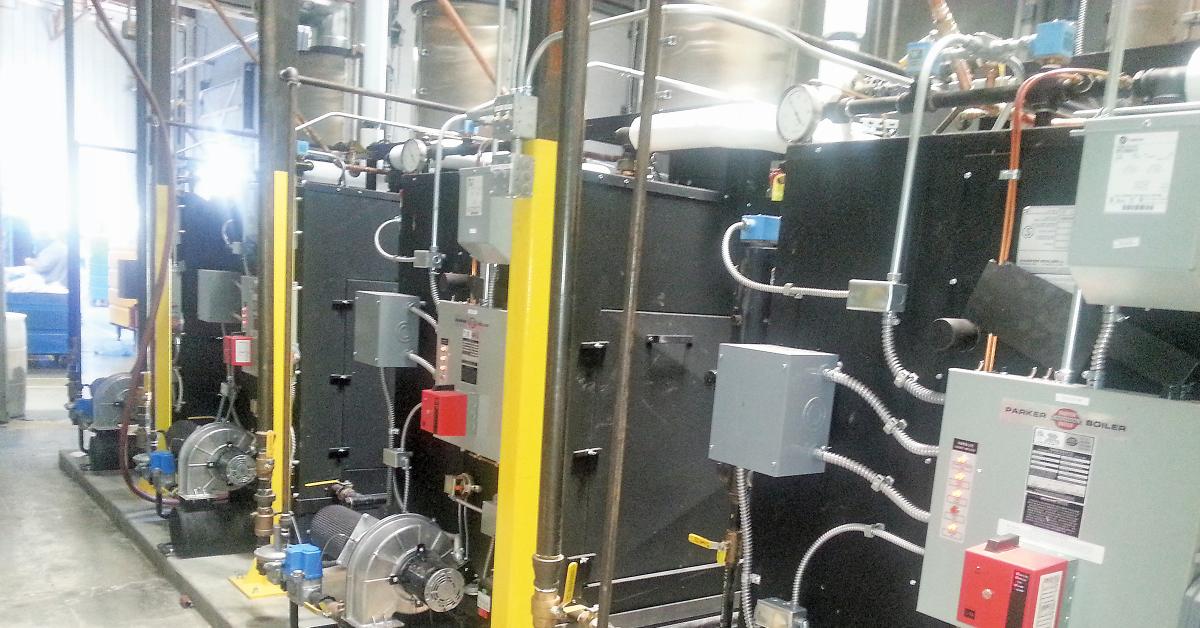CHICAGO — In the past, choosing a boiler for a laundry operation wasn’t very complicated.
“In the old days when capital purchase money or operational cost was not that much of an issue, typical commercial or industrial laundries would just purchase a 200-, 300-, 500-horsepower firetube boiler, normally just one,” says Michael Leeming, national sales manager for manufacturer Parker Boiler Co.
“All your eggs were in one basket—no standby, not much turndown, way oversized. If the boiler went down, you sent everyone home.”
Much has changed when it comes to laundry operations, and that has changed what boiler systems are used.
“In the last 10 years, the objective is generating a lower operational cost, or not running two or three shifts,” Leeming shares. “The newer tunnel washers use much less water, and have much more throughput, and newer ironers have helped achieve the objective of one shift per day.
“This saves owners a bunch of money on labor, utilities, etc.”
It’s important for operators to fully understand their plants and take into account key factors, from proper sizing to long-term reliability, to select the right boiler setup.
PROPER SIZING
Selecting a boiler properly sized for a laundry facility is the most important thing to Leeming.
“What is the equipment load now, and what might it be in the future at final build-out,” he says.
Leeming says that, typically, a laundry will have a tunnel washer or two, which is all live-steam injection from .4 to .16 gallons of water per pound of product. Then, it may have other types of washers with live-steam injection, using 2 to 2.5 gallons of water per pound of product.
“With this one-way steam, a pre-heater or sparger to elevate the feedwater to remove oxygen, which is detrimental to a boiler, or a deaerator should be considered,” he advises.
Leeming goes on to say that there may be a tempered water tank, which recovers the waste heat from the drain of the washers.
“There may also be a hot water tank that is being heated by a tank heater bundle, which reduces the amount of one-way steam, which saves on chemical, blow off, flash steam loss,” he says. “One-way steam is harder on the steam boilers, so it’s a good way to make hot water.”
Another possible big steam load in a laundry could be flatwork ironers, says Leeming. In some cases, these may be gas-fired, but more commonly they are steam.
“They need hot steam and typically about 30 horsepower per ironer at startup and a 20 horsepower run load,” he says.
When designing a steam system, a facility’s maximum load is a crucial factor. However, James Adgey, thermal sales, Clayton Industries, an industrial steam boiler manufacturer, says a common oversight is neglecting a plant’s minimum load.
“While your steam system needs to be able to handle its maximum demands, minimum demands are equally important,” he says.
As an example, Adgey imagines a facility that requires a large boiler system to manage all applications at once.
“However, if you only run at max capacity once or twice a week, that large boiler unit may be excessive for day-to-day operations, and you would instead benefit by having two smaller boilers, with the first able to handle daily demands and the second only coming online when it is needed for peak operation,” he says.
While this may represent a greater initial cost, doing so will not only give redundancy in the boiler system, but also result in even greater fuel savings, according to Adgey.
“Now it’s even more important to have a small boiler, as the laundry plant is not running over the weekend, let’s say, no steam, only a 10 horsepower load,” adds Leeming. “Many times we just put a small 9.5 horsepower boiler, which does not require a boiler room, attendant, annual inspections, etc.”
STEAM QUALITY
Most applications require steam with as high a quality as possible, and a commercial laundry is no exception.
“Ideally, steam quality should contain less than a single percentage of moisture, as this excess moisture can transfer into your product, which can be especially frustrating in presses, irons or steam tunnels,” Adgey says.
Andrew Elkind, marketing manager for Miura America, an industrial boiler manufacturer, says that the purpose of a laundry facility is to get fabrics clean, and having high-standard equipment is paramount to producing the best outcome.
“When looking for the right steam solution, it is important to consider the quality of the steam that the equipment will produce,” he says. “The steam that’s created from properly treated water produces the highest quality steam that gives facilities the best clean. So, it is recommended to compare the steam quality that steam equipment manufacturer produces to ensure you’re getting the best.”
Check back Tuesday for the conclusion with insights on examining response time, efficiency, safety and maintenance, emissions, and long-term reliability.
Have a question or comment? E-mail our editor Matt Poe at [email protected].

